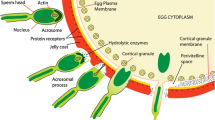Summary
Fertilization in the marine red algaAntithamnion nipponicum is a highly specific process involving non-motile male gametes, spermatia, and female receptive structures, carpogonia. FITC-lectin and Calcofluor white ST labelling show that the outer cell walls of spermatia differ from vegetative cells in carbohydrate composition. Specific binding of the lectins to spermatial walls was confirmed by lectin-gold labelling on thin sections. Gametic recognition inAntithamnion nipponicum is based on the interaction of a surface carbohydrate on the spermatia with a surface carbohydrate receptor on the trichogynes. Spermatial binding to trichogynes is inhibited by pre-incubation with concanavalin A and trichogyne receptors are blocked by the complementary carbohydrate α-D-methyl mannose. The inhibitory effects of concanavalin A to spermatial binding of trichogynes is reversed by preincubation with α-D-methyl mannose. The combination of long spermatial appendages and a carbohydrate-carbohydrate receptor-based gamete recognition mechanism make fertilization in this species an efficient process.
Similar content being viewed by others
References
Adair WS (1985) Characterization ofChlamydomonas sexual agglutinins. J Cell Sci [Suppl] 2: 233–260
Bolwell GP, Callow JA, Callow ME, Evans LV (1977) Cross-fertilization in fucoid seaweeds. Nature 268: 626–627
Broadwater ST, Scott JL, West JA (1991) Spermatial appendages ofSpyridia filamentosa (Ceramiaceae, Rhodophyta). Phycologia 30: 189–195
Callow JA (1985) Sexual recognition and fertilization in brown algae. J Cell Sci [Suppl] 2: 219–232
Craigie JS (1990) Cell walls. In: Cole KM, Sheath GR (eds) Biology of red algae. Cambridge University Press, New York, pp 221–258
Fetter R, Neushul M (1981) Studies on developing and released spermatia in the red alga,Tiffaniella snyderae (Rhodophyta). J Phycol 17: 141–159
Green JR, Jones JL, Stafford CJ, Callow JA (1990) Fertilization inFucus: exploring the gamete cell surface with monoclonal antibodies. In: Dale B (ed) Mechanism of fertilization. Springer, Berlin Heidelberg New York Tokyo, pp 189–202 (NATO ASI Series, series H, vol 45)
Hommersand MH, Fredericq S (1990) Sexual reproduction and cystocarp development. In: Cole KM, Sheath GR (eds) Biology of red algae. Cambridge University Press, New York, pp 305–346
Kim GH, Fritz L (1993) A signal glycoprotein with α-D-mannosyl residues involved in the wound-healing response ofAntithamnion sparsum (Ceramiales, Rhodophyta). J Phycol 29: 83–89
Lee IK, West JA (1980)Antithamnion nipponicum Yamada et Inagaki (Rhodophyta, Ceramiales) in culture. Jap J Phycol 28: 19–27
Løvlie A, Bryhni E (1976) Signal for cell fusion. Nature 263: 779–781
Maeda H, Ishida N (1967) Specificity of binding of hexapyranosyl polysaccharides with fluorescent brightener. J Biochem 62: 276–278
Magruder W (1984) Specialized appendages on spermatia from the red algaAglaothamnion neglectum (Ceramiales, Ceramiaceae) specially bind with trichogynes. J Phycol 20: 436–440
Peel MC, Duckett JG (1975) Studies of spermatogenesis in the Rhodophyta. Biol J Linn Soc 7 [Suppl 1]: 1–13
Samson M, Klis FM, Homan WL, van Egmond P, Musgrave A, van den Ende H (1987) Composition and properties of the sexual agglutinins of the flagellated green algaChlamydomonas eugametos. Planta 170: 341–321
Schmid C (1993) Cell-cell recognition during fertilization inEctocarpus siliculosus (Phaeophyceae). Hydrobiologia (in press)
Searles RB (1968) Morphological studies of red algae of the order Gigartinales. Univ Calif Publ Bot 43: 1–86
Sharon N, Lis H (1989) Lectins as cell recognition molecules. Science 177: 949–959
Sheath RG, Hambrook JH (1990) Freshwater ecology. In: Cole KM, Sheath GR (eds) Biology of red algae. Cambridge University Press, New York, pp 423–454
Weis WI, Drickamer K, Hendrickson WA (1992) Structure of Ctype mannose-binding protein complexes with an oligosaccharide. Nature 360: 127–134
West JW, Calumpong HP (1989) On the reproduction biology ofSpyridia filamentosa (Wulfen) Harvey (Rhodophyta) in culture. Bot Mar 32: 379–387
Author information
Authors and Affiliations
Rights and permissions
About this article
Cite this article
Kim, G.H., Fritz, L. Gamete recognition during fertilization in a red alga,Antithamnion nipponicum . Protoplasma 174, 69–73 (1993). https://doi.org/10.1007/BF01404044
Received:
Accepted:
Issue Date:
DOI: https://doi.org/10.1007/BF01404044




